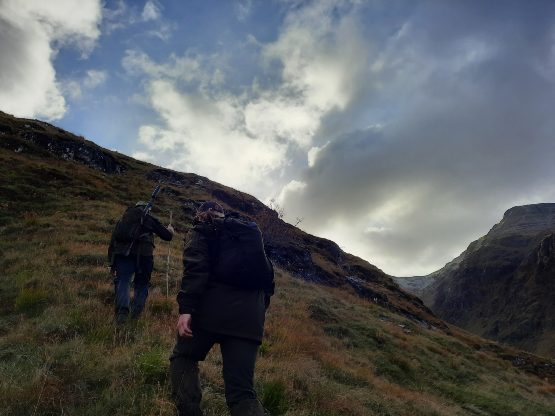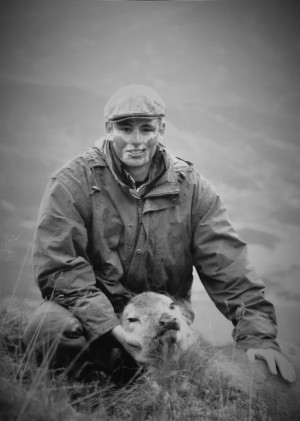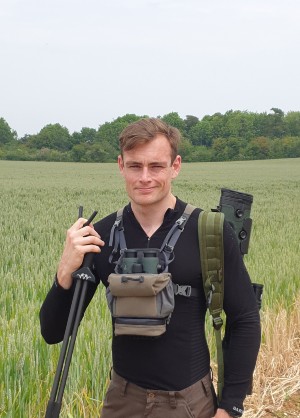Jonty Drew considers the importance of physical fitness in deer stalking.

Whilst out on a run the other day, it occurred to me, that fitness is sometimes overlooked in the deer stalking community, so I thought I would give my opinion on why I feel that fitness should be a more desirable trait for deer stalkers and why it should be encouraged.
I was overweight for quite a few years of my life. From a choice I made in my late teens, I managed to build my physical resilience and create a growth mindset that has led me to become the man I am today. This changed my life for the better and subsequently my performance, helping me to be relied upon as a stalking guide and in various other roles.
In the wider hunting community, physical fitness is often emphasised as a crucial asset due to the inhospitable environment’s hunters frequent worldwide. However, in the context of stalking such comparatively comfortable places, like many of England’s great counties, there exists a culture that heavily relies upon creature comforts. Although arguably more productive at times, the allure of high seats, heated gilets and nearby extraction vehicles, is far more appealing on a cold winters evening than stalking deep into the unknown.
Yet, true adventure lies in the unknown and if you happen to surrender to your curious instincts, discovering yourself in solitude surrounded by darkness at the foot of a hill, tasked with extracting a hefty fallow nobber, and aggressively contemplating your very existence, whilst burdened with excessive gear, then pay heed as you have been found wanting.
Of course, this has never happened to me but if it had, I would have needed to be able to extract, lift, carry or drag the carcass, whilst enduring the hill with cumbersome weight and without causing injury that could have serious consequences. All of these activities take a level of physical fitness that surpasses the ‘average Joe’, and which I believe, require training as a result.
Therefore, I am going to briefly cover a few areas to give a short insight into how they can increase your hunting performance and overall health, in order to encourage those sceptical of training to simply consider starting.
Cardiovascular fitness: Endurance, Stamina & Longevity:

Deer stalking often involves walking with a form of weight, sometimes covering quite a distance. A good degree of cardiovascular fitness (CV) can increase your endurance and general overall physical fitness, helping you to sustain the required level of activity for extended periods, ultimately increasing your chances of a successful outing.
Now, we all know that the work begins when the stalk ends, as gralloching and extracting the animal can be physically demanding and potentially exhausting. Being CV fit allows you to handle this process more efficiently, reducing fatigue and when combined with strength training, can ensure the proper care of the carcass when extracting and loading/unloading it into/out of the stalking vehicle.
Furthermore, CV fitness when trained consistently, will potentially give you the ability to stalk much later in life, as you would have developed a level of physical robustness and endurance that surpasses that of your average age group, helping your biological age be less than your numerical age. Therefore, CV fitness is arguably the most important element when hunting and if I was able to train only one element, this would be it.
Strength and Conditioning:
With the considerable amount of lifting, carrying & dragging that is involved in deer management, be that of equipment, the deer or indeed yourself, it is imperative that you have a level of strength that can assist you to complete the tasks in their entirety. Having a good level of strength gives you the ability to complete tasks quicker and more effectively, have more confidence on a solitary stalk and allows you to not only help yourself if something goes awry, but help others too. Furthermore, consistent strength training conditions the muscles around the joints and contributes to injury prevention, with long-term health benefits as a bonus.
Mobility, Flexibility and Agility:
 Stalking requires a level of stealth whilst sometimes navigating dense vegetation and uneven terrain. Mobility, flexibility and agility can contribute to your ability to move quietly, maintain balance, and stalk effectively, reducing the chances of bumping the deer and causing unnecessary injury to yourself, or damage to your beloved kit, when crossing obstacles and traversing hills. This can be implemented into your day quite easily by simply adding a short session of stretching and mobility work into your mornings or training sessions.
Stalking requires a level of stealth whilst sometimes navigating dense vegetation and uneven terrain. Mobility, flexibility and agility can contribute to your ability to move quietly, maintain balance, and stalk effectively, reducing the chances of bumping the deer and causing unnecessary injury to yourself, or damage to your beloved kit, when crossing obstacles and traversing hills. This can be implemented into your day quite easily by simply adding a short session of stretching and mobility work into your mornings or training sessions.
Mental focus and resilience:
Regular exercise and routine can improve mental clarity, concentration, and resilience. When stalking, maintaining focus and making robust decisions are paramount for success Being physically fit will enhance your mental resilience and capability in the field and ultimately help you make the right decisions.
Just ask yourself how many times you have been caught out trying to shift the deer into a position, being a simple drag or suspension and have had to ask for help or compromise the ideal situation because you simply could not get it there. This is when physical fitness assists in both judgement and individual ability. This is not to say that you shouldn’t rely on others, as teamwork should always be encouraged and is imperative to most situations. I simply believe that if the team is made up of capable, self-reliant individuals it will be far stronger for it.
However, this is also not saying that only fit individuals can stalk, as it is an activity loved by all and part of the stalking guides job is to make the experience as accessible and comfortable as possible. But if you happen to be fortunate enough to be able to train then I highly recommend you do, as it will almost certainly improve your personal experience.
Again, we have all been caught out, but if you consistently train the physical disciplines needed to counter these situations it will pay off. Also, if you could instantly invest in something that would make you a better hunter, a better teammate, more physically robust and reliable, healthier, stronger and potentially give you more years to do what you love, I guarantee you would do it.
Ultimately, physical fitness will give you many advantages when stalking and in general life, but it must be noted that stalking skills, the knowledge of deer behaviour and ecology and practical experience will always prevail as the primary deer management tool. What I am simply asking you to do is consider the potential of the two when combined.
 As well as being an Ultra Marathon Runner, Jonty Drew is a PDS1 Approved Verifier in Deer Stalking Qualifications, DMQ Approved Witness, and experienced stalking guide. He holds an Extended Diploma in Countryside Management, Game & Wildlife from Sparsholt College with distinction and is currently working towards a BSc in Wildlife Conservation and Environmental Management at the prestigious 'Harper Adams University'.
As well as being an Ultra Marathon Runner, Jonty Drew is a PDS1 Approved Verifier in Deer Stalking Qualifications, DMQ Approved Witness, and experienced stalking guide. He holds an Extended Diploma in Countryside Management, Game & Wildlife from Sparsholt College with distinction and is currently working towards a BSc in Wildlife Conservation and Environmental Management at the prestigious 'Harper Adams University'.
With more than a decade of experience in the industry, Jonty has had the privilege to train and mentor numerous individuals in achieving their various deer management & stalking qualifications.
To read more from Jonty follow this link: roebuck-management
If you’d like to learn to hunt deer, a great place to start is by taking the ‘Proficient Deer Stalker Level 1 Course, which is available here via the ‘Shooting & Hunting Academy’ deer-stalking-course



















